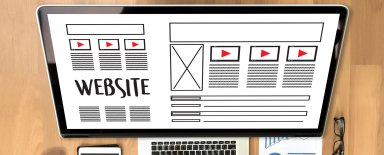
5 Landing Page Elements that are Worth Using on Your Website
A well-thought-out landing page will allow you to achieve your goals - obtain information about potential clients, make contact with them, and even sell products or services. Are you considering creating a landing page for your company? Before you design it, think about what exactly you want to achieve. In this article, we'll describe the elements that shouldn't be missing on any landing page.
What is a landing page?
In digital marketing, a landing page is a single web page created with marketing campaigns in mind. It's the page that pops up when someone clicks on a Google search result, link from a marketing email, or link from a social media post.
Creating an appropriate landing page eliminates distractions while browsing it and simplifies the process of submitting offers. Therefore, good landing page design is the key to its effectiveness.
Although a landing page works as part of a marketing campaign, it doesn't have to look like a typical advertising tool, i.e., containing a large number of banners promoting goods or services and slogans encouraging you to buy.
What is the purpose of a landing page?
A landing page is created with a specific goal in mind. It doesn't have to be related to selling a product, but, e.g., establishing contact with a potential client, adding another user's address to the newsletter, obtaining additional information needed to better personalize the site, promoting an event (a landing page may be dedicated to a training course or conference).
Every such page is designed for a specific type of reader or with the hope of achieving specific goals. This means not only that the content of landing pages should be varied, but also that various approaches may be used when creating them. There are several elements, however, that can be used to increase the effectiveness of marketing campaigns using landing pages.
1. Interesting Hero section
The hero section is the first part of a landing page that the recipient sees after being redirected from the ad to the page. In the first seconds, you can use this section to send a clear message and interest the recipient by applying the appropriate measures here.
There are many options. You may:
- present original graphics,
- embed a video,
- use different call to action buttons (e.g., Start now, Try the demo version),
- use drop-down contact forms.
In the case of a hero image, the context is important. Add graphics that will let the recipient understand what you do and what benefits they can obtain by working with you. It's also a good idea to create an interesting or intriguing headline for this section.
The Semrush landing page has a simple Hero section, the main element of which is the headline. The short slogan Explore the Competitive Landscape of Your Industry succinctly indicates the purpose of the offered solution. The CTA button in the center encourages you to try the tool for free.
Source: Semrush
2. Catchy headlines and content
It's good to limit the length of the contents published on the landing page and focus on providing a short but specific message. These types of pages often contain short paragraphs and a large number of headings of different orders that separate individual sections on the page and signal important characteristics of the product or service. A strong headline may attract visitors as effectively as great photos.
Your headline should be understandable, direct, and precisely explain what your offer is. It must clearly communicate what you are proposing and why it might be of value to the reader. If one headline isn't enough to briefly explain what you're offering to the potential client, use additional headlines. The additional headline may be a natural extension of the main headline, enhance the message, give the recipient additional information, etc.
Check out how the landing page of Landingfolio uses the headline. It defines the target group of this page, formulating the problem of the potential client (difficulty in creating content). The subheading briefly describes the solution and the benefits of choosing it.
The headline of the OutSkirts Press landing page refers to one of the biggest problems of its target group (authors). It briefly describes the offer and the benefits of choosing it. In addition, in order to strengthen the message, the creators put "100%" (of profits and rights) in it, and as you know, numbers usually appeal to the audience better than words.
Source: OutSkirts Press
3. Proper contact form
Think about where you want to put the contact form. This element enables achieving a specific goal, e.g., obtaining information about the client or arranging a conversation with the seller. The forms should be short and simple, asking only for the necessary information – gather only the information that you really need. Their form should encourage the user to achieve the landing page conversion goal.
Users are reluctant to spend time filling out forms, especially if they're long. Consider how to eliminate their doubts. You can dispel the data security concerns by briefly explaining how the data will be used and secured. You can encourage users to complete forms by offering additional value for submitting the data (e.g., a free e-book, free access to a premium account for a limited period, etc.). You can also prepare an automatic email with a request to confirm registration or transfer of data to make contact or check whether the provided email address is real.
Also, consider using multi-step forms. They usually don't take up as much space as a single multi-field form. You may design an animation that'll show the client what stage of filling out the form they are currently at, which will reduce the likelihood that the user will get irritated and leave the page.
The form on the Nauto landing page is extensive but filling it out is much faster thanks to the drop-down lists from which you can choose answers to most of the questions. Such an approach allows the company to obtain a lot of information necessary to draw up a personalized offer, and at the same time, it ensures that the user won’t waste a lot of time filling out the form.
4. Compelling social proofs
As a rule, a person who doesn't have enough information to make a decision on their own adopts the views of a certain majority (e.g., a given group of clients or users). The visitors are more likely to make a purchase if they see that others have chosen your offer before. You may use social proof, e.g., by displaying the logos of the clients who have already used your services or are still working with your brand, and by posting their testimonials.
Additional confirmation of interest in your brand could be, e.g., the number of registrations on your website, activity statistics on social media, or awards from reputable organizations. The fact that others are watching your online activity and buying what you offer makes potential clients believe that your product is worth their interest. You can embed a section with testimonials in the form of a carousel to showcase different examples of feedback from the clients or create a static section with the comments on your business, services, or products selected by you.
Quote short but specific testimonials from clients – the ones that indicate what was the actual problem your services helped to solve. Provide the names and job descriptions of the people who speak about your brand, and use photos if possible. You may also post an interview with a satisfied client.
The Unbounce company integrates client testimonials into the descriptions and graphics on its product pages. In this way, when potential client learns about the product's functionalities, they immediately see the reasons for making a purchase thanks to positive feedback from satisfied clients. Short opinions are accompanied by photos of their authors, their names, job description, and the name of the company they represent.
Source: Unbounce Landing Page
Slack publishes client opinions about the specific advantage of using their solutions next to the section with the appropriate description. For example, with a headline indicating that numerous integrations improve end-client problem-solving, there's a comment confirming that the time needed to help the clients has been reduced with the use of this solution.
The landing page of Slack's solution for client service teams.
5. Efficient CTA
All the elements of a landing page and the approaches taken come down to one thing – making the user click the CTA button which will redirect them to performing a certain action (logging in into the trial version of the application, filling out a form, etc.). Choose the words you want to put on the button carefully. Be clear about what the website visitors will receive. Give up clichéd CTAs like learn more. Choose slogans that'll effectively convince your potential client to perform a specific action.
The call to action may be a part of a lead generation form or a standalone button on the landing page. Think carefully about how to design a CTA and where to put it. Use contrasting colors to make this button stand out. It should be visible to the client right after opening the website.
The CTA on the Animaker landing page is clearly visible immediately after entering the landing page, as it’s located in the Hero section. In addition, it stands out due to the eye-catching color of the button, which encourages trying out the demo.
Landing page elements - summary
The landing page elements described above are basically the ingredients that must be present on any landing page in order for it to fulfill its function. Content, photos, and videos help your potential client understand what you're offering. Social proofs and testimonials motivate the users to take action. Forms and CTA buttons encourage to contact the company, but also simply allow for taking an action. We'll be happy to help you design and develop a landing page in Drupal.











